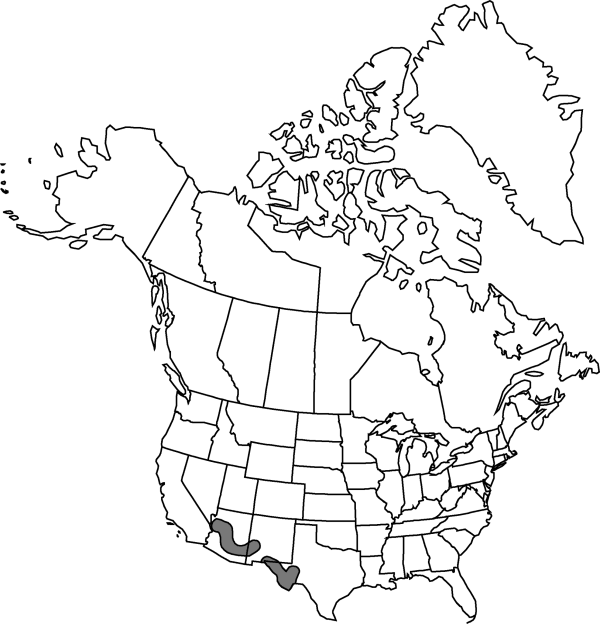Difference between revisions of "Atriplex wrightii"
Proc. Amer. Acad. Arts 9: 113. 1874.
FNA>Volume Importer |
FNA>Volume Importer |
||
| Line 24: | Line 24: | ||
|elevation=400-1200 m | |elevation=400-1200 m | ||
|distribution=Ariz.;N.Mex.;Tex.;Mexico. | |distribution=Ariz.;N.Mex.;Tex.;Mexico. | ||
| − | |discussion=<p>The name Obione elegans var. radiata was discussed by H. M. Hall and F. E. Clements (1923), who did not see the Thurber type material, but did see another cited specimen, Wright 571, from west Texas, which is referable to Atriplex elegans. The concept of A. radiata, according to Coulter, includes A. wrightii as a synonym; the description supplied by him is of that entity.</p> | + | |discussion=<p>The name Obione elegans var. radiata was discussed by H. M. Hall and F. E. Clements (1923), who did not see the Thurber type material, but did see another cited specimen, Wright 571, from west Texas, which is referable to <i>Atriplex elegans</i>. The concept of A. radiata, according to Coulter, includes <i>A. wrightii</i> as a synonym; the description supplied by him is of that entity.</p> |
|tables= | |tables= | ||
|references= | |references= | ||
| Line 48: | Line 48: | ||
|publication year=1874 | |publication year=1874 | ||
|special status= | |special status= | ||
| − | |source xml=https://jpend@bitbucket.org/aafc-mbb/fna-data-curation.git/src/ | + | |source xml=https://jpend@bitbucket.org/aafc-mbb/fna-data-curation.git/src/8f726806613d60c220dc4493de13607dd3150896/coarse_grained_fna_xml/V4/V4_707.xml |
|genus=Atriplex | |genus=Atriplex | ||
|subgenus=Atriplex subg. Obione | |subgenus=Atriplex subg. Obione | ||
Revision as of 17:30, 18 September 2019
Herbs, annual. Stems erect and ascending, sparsely branched or simple, obtusely angled, 1.5–10(–15) dm, stout, scurfy when young. Leaves sessile or short petiolate; blade white abaxially, green adaxially, linear to lanceolate, elliptic, or oblong, 15–75 × (1–)3–25 mm, thin, base cuneate to long attenuate, margin coarsely sinuate-dentate or entire, apex rounded to acute, mucronate, densely scurfy and pale abaxially, green and glabrous adaxially. Staminate flowers in glomerules, forming slender, usually dense, naked terminal narrowly paniculate spikes, panicles 6–30 cm; glomerules beadlike, small, 2–3 mm thick; calyx 5-cleft. Pistillate flowers in few-flowered axillary clusters. Fruiting bracteoles short stipitate, cuneate-orbiculate or broadly cuneate, compressed, 2–2.5 mm, united basally, apex rounded, acutely 5-dentate, faces 3-veined, usually unappendaged, rarely obscurely tuberculate. Seeds pale brown, 1 mm.
Phenology: Flowering summer–fall.
Habitat: In alkaline or saline substrates, often along roadsides, in old fields and vacant lots
Elevation: 400-1200 m
Distribution

Ariz., N.Mex., Tex., Mexico.
Discussion
The name Obione elegans var. radiata was discussed by H. M. Hall and F. E. Clements (1923), who did not see the Thurber type material, but did see another cited specimen, Wright 571, from west Texas, which is referable to Atriplex elegans. The concept of A. radiata, according to Coulter, includes A. wrightii as a synonym; the description supplied by him is of that entity.
Selected References
None.